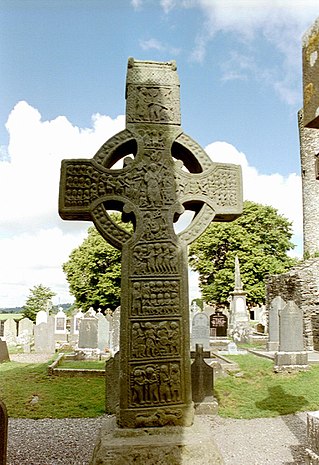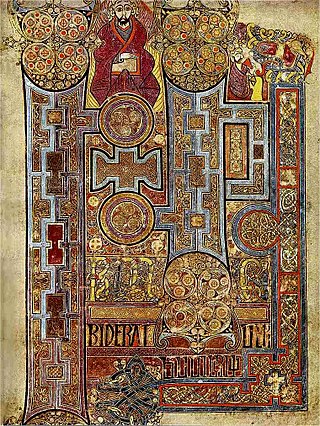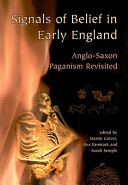
The Anglo-Saxons were a cultural group that inhabited much of what is now England in the Early Middle Ages, and spoke Old English. They traced their origins to Germanic settlers who came to Britain from mainland Europe in the 5th century. Although the details are not clear, their cultural identity developed out of the interaction of these settlers with the pre-existing Romano-British culture. Over time, most of the people of what is now southern, central, northern and eastern England came to identify as Anglo-Saxon and speak Old English. Danish and Norman invasions later changed the situation significantly, but their language and political structures are the direct predecessors of the medieval Kingdom of England, and the Middle English language. Although the modern English language owes somewhat less than 26% of its words to Old English, this includes the vast majority of words used in everyday speech.

A high cross or standing cross is a free-standing Christian cross made of stone and often richly decorated. There was a unique Early Medieval tradition in Ireland and Britain of raising large sculpted stone crosses, usually outdoors. These probably developed from earlier traditions using wood, perhaps with metalwork attachments, and earlier pagan Celtic memorial stones; the Pictish stones of Scotland may also have influenced the form. The earliest surviving examples seem to come from the territory of the Anglo-Saxon kingdom of Northumbria, which had been converted to Christianity by Irish missionaries; it remains unclear whether the form first developed in Ireland or Britain.
Medieval archaeology is the study of humankind through its material culture, specialising in the period of the European Middle Ages. At its broadest, the period stretches from the 5th to the 16th century and refers to post-Roman but pre-modern remains. The period covers the upheaval caused by the Fall of the Western Roman Empire and cultures such as the Vikings, the Saxons, and the Franks. Archaeologists often specialise in studying either the Early Middle Ages or the High Middle Ages and Late Middle Ages, although many projects and professionals move across these chronological boundaries. The rich nature of the medieval written record means that archaeology has often been seen as the "handmaiden to history", especially in the Late Middle Ages. Analysis of material culture may enrich or call into question written evidence from the medieval period and the two sources of evidence need to be used together. Medieval archaeology has examined the development of medieval settlements, particularly the development of medieval towns, monasteries, and castles. It has also contributed to understanding of the spread and development of Christian monasticism during the medieval period.

The Alfred Jewel is a piece of Anglo-Saxon goldsmithing work made of enamel and quartz enclosed in gold. It was discovered in 1693, in North Petherton, Somerset, England and is now one of the most popular exhibits at the Ashmolean Museum in Oxford. It has been dated to the late 9th century, in the reign of Alfred the Great, and is inscribed "AELFRED MEC HEHT GEWYRCAN", meaning "Alfred ordered me made". The jewel was once attached to a rod, probably of wood, at its base. After decades of scholarly discussion, it is now "generally accepted" that the jewel's function was to be the handle for a pointer stick for following words when reading a book. It is an exceptional and unusual example of Anglo-Saxon jewellery.

Anglo-Saxon art covers art produced within the Anglo-Saxon period of English history, beginning with the Migration period style that the Anglo-Saxons brought with them from the continent in the 5th century, and ending in 1066 with the Norman Conquest of England, whose sophisticated art was influential in much of northern Europe. The two periods of outstanding achievement were the 7th and 8th centuries, with the metalwork and jewellery from Sutton Hoo and a series of magnificent illuminated manuscripts, and the final period after about 950, when there was a revival of English culture after the end of the Viking invasions. By the time of the Conquest the move to the Romanesque style is nearly complete. The important artistic centres, in so far as these can be established, were concentrated in the extremities of England, in Northumbria, especially in the early period, and Wessex and Kent near the south coast.

Anglo-Saxon paganism, sometimes termed Anglo-Saxon heathenism, Anglo-Saxon pre-Christian religion, or Anglo-Saxon traditional religion, refers to the religious beliefs and practices followed by the Anglo-Saxons between the 5th and 8th centuries AD, during the initial period of Early Medieval England. A variant of Germanic paganism found across much of north-western Europe, it encompassed a heterogeneous variety of beliefs and cultic practices, with much regional variation.

Insular art, also known as Hiberno-Saxon art, was produced in the post-Roman era of Great Britain and Ireland. The term derives from insula, the Latin term for "island"; in this period Britain and Ireland shared a largely common style different from that of the rest of Europe. Art historians usually group Insular art as part of the Migration Period art movement as well as Early Medieval Western art, and it is the combination of these two traditions that gives the style its special character.
Roberta Lynn Gilchrist, FSA, FBA is a Canadian-born archaeologist and academic specialising in the medieval period, whose career has been spent in the United Kingdom. She is Professor of Archaeology and Dean of Research at the University of Reading.
Howard M. R. Williams is a British archaeologist and academic who is Professor of Archaeology at the University of Chester in England. His research focuses on the study of death, burial and memory in Early Medieval Britain.

The settlement of Great Britain by diverse Germanic peoples, who eventually developed a common cultural identity as Anglo-Saxons, changed the language and culture of most of what became England from Romano-British to Germanic. This process principally occurred from the mid-fifth to early seventh centuries, following the end of Roman rule in Britain around the year 410. The settlement was followed by the establishment of the Heptarchy, Anglo-Saxon kingdoms in the south and east of Britain, later followed by the rest of modern England, and the south-east of modern Scotland. The exact nature of this change is a topic of on-going research. Questions remain about the scale, timing and nature of the settlements, and also about what happened to the previous residents of what is now England.

Anglo-Scandinavian is an academic term referring to the hybridisation between Norse and Anglo-Saxon cultures in Britain during the early medieval period. It remains a term and concept often used by historians and archaeologists, and in linguistic spheres.
Andrew Reynolds is an English archaeologist specialising in the study of medieval Britain. He is a lecturer at the Institute of Archaeology, University College London. Reynolds worked as a field archaeologist from 1985 to 1990 before going on to gain a BA in Medieval Archaeology and a PhD from University College London.
Stephen Pollington is an English author who specialises in Anglo-Saxon England and the Old English language who has written a number of books on the subject, most of which have been published by the company Anglo-Saxon Books.

Signals of Belief in Early England: Anglo-Saxon Paganism Revisited is an academic anthology edited by the British archaeologists Martin Carver, Alex Sanmark and Sarah Semple which was first published by Oxbow Books in 2010. Containing nine separate papers produced by various scholars working in the fields of Anglo-Saxon archaeology and Anglo-Saxon history, the book presents a number of new perspectives on Anglo-Saxon paganism and, to a lesser extent, early Anglo-Saxon Christianity. The collection – published in honour of the archaeologist Audrey Meaney – was put together on the basis of a conference on "Paganism and Popular Practice" held at the University of Oxford in 2005.
Audrey Lilian Meaney was an archaeologist and historian specialising in the study of Anglo-Saxon England. She published several books on the subject, including Gazetteer of Early Anglo-Saxon Burial Sites (1964) and Anglo-Saxon Amulets and Curing Stones (1981).

In the early Middle Ages, there were distinct material cultures evident in the different federations and kingdoms within what is now Scotland. Pictish art was the only uniquely Scottish medieval style; it can be seen in the extensive survival of carved stones, particularly in the north and east of the country, which hold a variety of recurring images and patterns. It can also be seen in elaborate metal work that largely survives in buried hoards. Irish-Scots art from the kingdom of Dál Riata suggests that it was one of the places, as a crossroads between cultures, where the Insular style developed.
Dawn Marie Hadley is a British historian and archaeologist, who is best known for her research on the Anglo-Saxon and Viking Age periods, the study of childhood, and gender in medieval England. She is a member of the Centre for Medieval Studies and the department of archaeology at the University of York.
The Society for Medieval Archaeology was founded in 1957. Its purpose was to publish a journal on medieval archaeology and organise conferences and events around the subject. It was the third archaeological society founded with a focus on a particular period, after the Prehistoric Society of East Anglia (1908) and the Society for the Promotion of Roman Studies (1911).

House-shaped shrine are early medieval portable metal reliquary formed in the shape of the roof of a rectangular building. They originate from both Ireland and Scotland and mostly date from the 8th or 9th centuries. Typical example consist of a wooden core covered with silver and copper alloy plates, and were built to hold relics of saints or martyrs from the early Church era; a number held corporeal remains when found in the modern period, presumably they were parts of the saint's body. Others, including the Breac Maodhóg, held manuscripts associated with the commemorated saint. Like many Insular shrines, they were heavily reworked and embellished in the centuries following their initial construction, often with metal adornments or figures influenced by Romanesque sculpture.
Raghnall Ó Floinn FSA is an Irish art historian and former director of the National Museum of Ireland (NMI), who joined its staff in 1976 and becoming its director in 2013.










